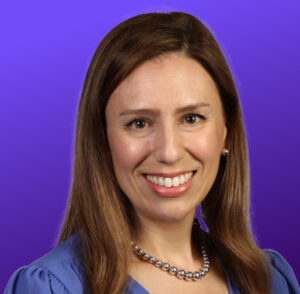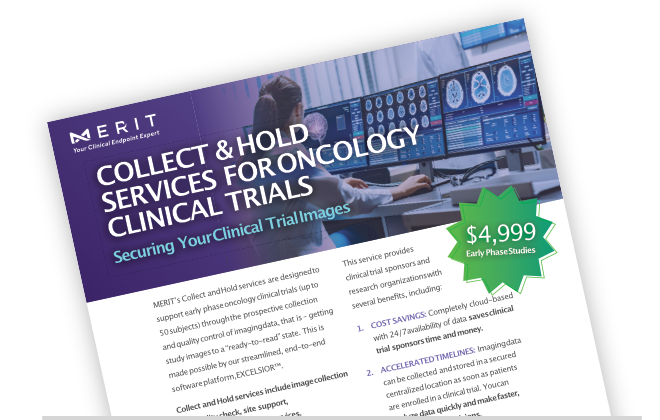MERIT’s webinar provided an interactive Q & A-style session discussing how early phase centralized image storage can help sponsors secure funding. As background, image repository services are the prospective collection and quality control of imaging data for a clinical study, that is–getting study images to a “ready-to-read” state. This type of study is usually referred to as “Collect and Hold.”
Key Takeaways
- Data from early phase trials are vital for generating publications, defining larger clinical programs, and securing funding
- Prospective collection of imaging data from early phase trials allows for central review to validate locally observed response data
- Collect and Hold may significantly reduce the cost of full central image review
- A key benefit is the sponsor’s ability to demonstrate the study/treatment effect has been independently validated
Webinar host Seokyeong (Gene) Kim, PharmD, MERIT’s Clinical Scientist, led a discussion of the following questions with panelists Jim Golando, clinical operations and imaging clinical trial expert and founder of Golando Advisory Group, and Catherine Chintala, MERIT Project Manager, Oncology.
When Transitioning from Pre-Clinical to Clinical Studies, How Is Imaging Related to Fund-Raising Activities?
Jim Golando: Early phase studies are primarily designed to assess safety, pharmacokinetics, and in some cases, possibly identify a recommended Phase 2 dose. Often, secondary objectives evaluate early clinical activity assessed locally by the investigator.
Generally, in smaller biopharma/biotech companies, it is the data from these studies which is used to generate publications, help in designing larger clinical studies, and used as a primary resource to secure funding.
The prospective collection of imaging data in these early phase clinical studies provides for consistency in image acquisition while ensuring overall quality of the images. Perhaps more importantly, prospective image collection allows for the possible central review of all or selected subject data to validate locally observed response data, which may bolster fundraising efforts.
Why Is This Approach Helpful with Early Phase Studies?
Jim Golando: This approach of prospectively collecting imaging data but not initially completing reads, may significantly reduce the cost of a full prospective central image review which is typically done in larger pivotal clinical studies. Importantly, in the Collect and Hold model, reads can be done once there is a clear sign of clinical activity based on locally assessed treatment effect.
It is also helpful and cost-effective that these reviews may be done only in selected subjects, for example, subjects that show clinical benefit such as Stable Disease (SD), Partial Response (PR), or Complete Response (CR) before taking a decision on evaluating all subjects.
As background, SD is used to describe a tumor that is neither growing nor shrinking, PR is a decrease in the size of a tumor or in the amount of cancer in the body, and CR is the disappearance of all signs of cancer in the body.
Once the decision is made to read in the Collect and Hold model, it is usually done with one reader (or radiologist) which can significantly reduce both time and cost.
A key benefit with this approach is the ability to demonstrate that the study/treatment effect has been independently validated. This helps to establish the scientific validity of the research and provides more robust evidence for the accuracy and reliability of the results. It enhances trust and confidence in the research findings and reduces the potential for bias.
What Are Some Potential Obstacles with Early Imaging Studies?
Catherine Chintala: As Jim mentioned, early phase studies are often looking at safety. Data are very closely monitored and decisions about the study often need to be made quickly. Although imaging doesn’t always support the primary endpoint, it’s critical that the data contained in the images isn’t lost. Imaging will often be performed as standard of care, meaning that the sites will perform the scans anyway and assessments will occur at the local level. Taking steps to proactively collect the images in a standardized way can offer many benefits, but it’s not without obstacles. However, working closely with an imaging endpoint expert can help mitigate challenges such as:
- Busy study sites
- Variation of image acquisition and interpretation across sites
- Lack of a centralized location for images collected across different clinical sites
An imaging endpoint expert can also help mitigate study management challenges like:
- Assessing the status of subjects and time points
- Where are the time points in the process?
- Lack of visibility and transparency
- Access to data and images
- Lack of access to Subject Matter Experts and expert readers
- Navigating multiple software systems
- Navigating agency guidance and response criteria
Jim Golando: The issues Catherine nicely outlined are not often considered when implementing early phase studies since again, the focus is essentially on safety, and the typical central review process can be costly and not justified in an early phase study. However, in many cases, early clinical activity can be assessed, and including a Collect and Hold model for the imaging data can be invaluable and safeguard against the issues mentioned earlier.
The Collect and Hold process allows for collection of high-quality images by employing strict quality control measures. Dedicated imaging quality control experts are essential to the process. They ensure the highest imaging data quality, by employing standardized acquisition and processing protocols, which provide reliable and reproducible data.
Collect and Hold will also provide consistency in image evaluation from multiple sites, should a decision be made to review some or all subjects. Consistency is extremely difficult to achieve without proper oversight and training. If a read is performed, it will be done by well-trained and experienced radiologists in a very controlled process to ensure consistency.
Finally, the Collect and Hold process will also ensure all available images are prospectively collected and stored.
Based on Your Experience, How Should Sponsor Companies and Sites Ensure Good Image Quality from the Beginning of the Clinical Trial?
Catherine Chintala: Working closely with an imaging expert as early as possible is critical. Sometimes an imaging core lab is brought into the study planning at a later stage, but we have found that incorporating imaging into your early stage of planning is key. This partnership results in the most appropriate imaging parameters for the protocol and charter. It also helps to ensure that the sites have clear expectations of the imaging that is needed, and any potential questions and issues can be addressed upfront. Making imaging part of your early phase trial can offer benefits that extend well beyond the study.
How Can MERIT’s Collect and Hold Services Accelerate Drug Development Timelines and Provide Better Data Outcomes?
Catherine Chintala: With MERIT’s Collect and Hold services, imaging data can be collected and stored in a secured centralized location as soon as patients are enrolled in a clinical trial. You can analyze data quickly and make faster, more informed decisions. With high quality images already properly curated and stored, you can enjoy cost-savings and avoid the time-consuming and resource-intensive process of chasing down old images. MERIT’s Collect and Hold service is completely cloud-based with 24/7 availability of data and powered by our transparent and streamlined EXCELSIOR™ software platform.
Collect and Hold can benefit studies in a variety of phases. For example, early phase studies that aren’t quite ready to invest in an independent review can benefit from the standardized collection of images, and transition quickly and easily to an independent review. Trying to retrospectively collect images that were performed in the past is very challenging. I like to think of the Collect and Hold services as an investment in your program’s future. Making a small initial investment upfront will save both time and money, not to mention frustration, in the long run.
MERIT’s Collect and Hold services comply with FDA, EMA, and ICH guidelines, ensuring that all imaging data is collected and stored in accordance with regulatory requirements. Our Collect and Hold services fit any study budget, allowing even small or early phase studies to realize the benefits of working with an established imaging core lab.
Highlights from the Q&A
Q: What is the benefit of a prospective Collect and Hold versus a retrospective collection and review?
A: Collect and Hold studies have many benefits, but the main way they differ from a retrospective study is that images are collected as they are performed, just as we would in a full-scope study. In a retrospective study, what usually happens is that a sponsor decides to collect images after the study is complete, maybe because they want to confirm findings in a later phase study, or because they want to add data from a different group of subjects.
The challenge is that the scans were performed in the past, perhaps months or even years ago. It’s hard for sites to go back and pull images from the past, so data may be missing or incomplete. Another challenge is that the images weren’t standardized to a single set of parameters, so you could have different levels of quality and/or incomplete anatomical coverage. Doing a Collect & Hold study ensures that you collect standardized scans as they occur, which results in a cleaner, more complete database of images.
Q: Will a Collect and Hold component add any burden to the site staff?
A: Not at all. Participating in a Collect and Hold study looks and feels like a standard study from the point of view of a study site. A study site can expect to receive imaging resources and support from MERIT, and questions or queries about scans can be addressed very close to when the scan was performed. Working with MERIT also benefits the site because they interface with one system. The web-based EXCELSIOR software is their one-stop shop for imaging guides, queries, and is the place where they upload all subject scans.
Q: Will adding Collect and Hold impact study timelines?
A: No, in fact, performing a Collect and Hold study can shorten timelines. If a sponsor has a Collect and Hold, and later decides to expand the study scope to include an independent review, we can gear up very quickly for a read. The scans are already in-house and ready, and we will focus on doing a charter amendment to include the read and getting the database configured for the reads to be performed. This can be done in a much quicker fashion than starting from scratch and needing to collect scans, do quality control, do queries, and get everything in a ready-to-read state retrospectively.
Q: What is the timing for implementation of a Collect and Hold study?
A: After the study award, the team will be in study start-up mode, which includes creating all study documents, such as the site manuals and materials, project plan, and abbreviated Charter. It also includes internal and external kick-off meetings and database creation. The process will take approximately 4-6 weeks from study award to being able to receive scan uploads from sites. During this time period, the study team works very closely with the sponsor to get all of the documentation finalized. They also work closely with the sites to establish a relationship and ensure that the site can access the software and upload subject scans.
Q: How do you implement a retrospective study? What are the challenges?
A: To implement a retrospective study, we really follow the same steps as we would for a prospective study, but we don’t create site manuals and site surveys. We would still build the database and create study documentation. We would also have discussions with the sponsor about how to handle queries: do we go back to the sites with quality issues or to look for missing exams, or do we immediately resolve any issues that are found? This is the biggest challenge of a retrospective study–what to do when we find that something is missing or poor quality. Ultimately, there could be gaps in the data that will affect the read, and potentially cause lost responses.
At MERIT, we’re passionate about helping companies that may not be considering imaging or might be new to imaging. Educating and partnering with our sponsors to ensure that imaging runs smoothly is very important to our team, no matter the size or phase of the study.
We feel that making a smaller investment in a Collect and Hold service upfront is like insurance for your data, and helps to save money and time later on.
Why MERIT?
Innovative. Proven. Experienced.
MERIT has provided image collection, centralized reading, and data management services for clinical trials since 2012. Using our innovative and proven technologies and intuitive, seamless workflows, MERIT’s experienced staff brings more than a decade of clinical endpoint expertise to ensure the success and integrity of your independent imaging review studies.
Partnerships with MERIT provide the following advantages:
- Experience in managing clinical trials
- Single platform for all study data, queries, reporting/tracking, image transfer, and analysis
- Oncology experienced staff
- Step-by-step Imaging Protocols, SOPs, and document support
- Indispensable regulatory support and guidance
- Established, time-tested Quality Assurance, security, and data privacy
View full webinar video:

Jim GolandoClinical Operations and Imaging Clinical Trial Expert
Jim Golando has 30+ years of experience in the pharmaceutical and biotech industries. His expertise ranges from Phase I through late-stage development and lifecycle management, with particular strengths in imaging clinical trials, clinical research, clinical operations, procurement/outsourcing, project/team leadership, and project management. He has overseen the operational and developmental planning and execution of global clinical trials in imaging, oncology, respiratory, endocrine, anti-infectives, and cardiology. Jim held senior leadership positions as Chief of Operations at Ora, Inc. and Median Technologies. He was previously VP of Medical Affairs at BioClinica, and held clinical operation positions at Schering-Plough, Novartis, and Hoffman-La Roche. Jim founded Golando Advisory Group and has been consulting since 2012.

Catherine Chintala, PMPDIRECTOR OF OPERATIONS, ONCOLOGY
Catherine Chintala works at MERIT as a Project Manager in our oncology division. With 20 years of experience working in clinical trials and the CRO industry, she has expertise managing oncology clinical trials from start up to close out. Catherine works closely with sponsors, designing and implementing processes to meet project timelines and helping to ensure study needs are clearly communicated across key stakeholders. Drawing upon her experience in a variety of indications and response criteria, Catherine can partner with your team to help make your clinical trial a success.



